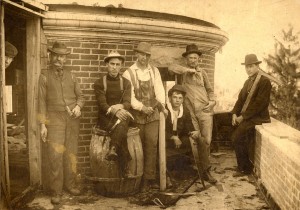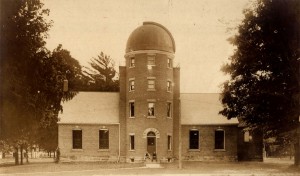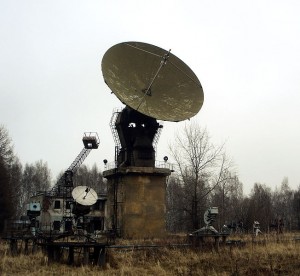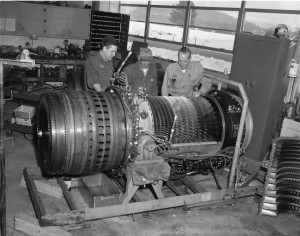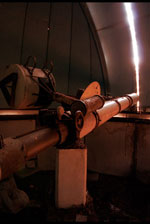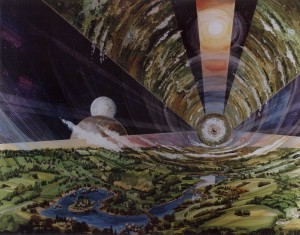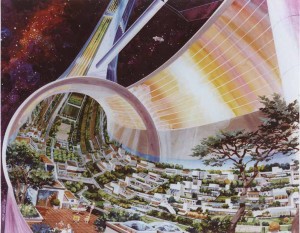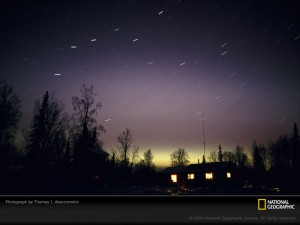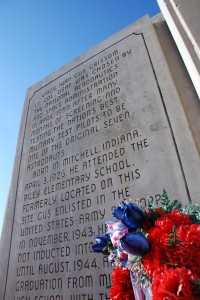
Gus Grissom Monument, Mitchell, Indiana, January 2012. Photo credit: JR
One of the first places we visited after moving to Indiana in 1997 was the Gus Grissom Memorial at Spring Mill State Park, just east of Mitchell, Indiana. The memorial display was pretty minimalistic back then, consisting of the Gemini 3 space capsule “Molly Brown” and a case with Grissom’s space suit, helmet and gloves.
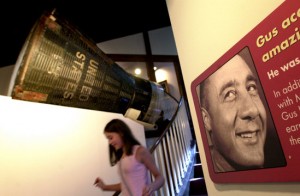
Gemini 3 Space Capsule at Gus Grissom Memorial, July 2001. Photo credit: Karen Ducey
Still, it was pretty awesome, because you could get up close and personal with the space capsule. In 2009, the memorial was renovated completely. And when I say “completely,” I mean COMPLETELY. We stopped to visit on our way into the park to do some winter hiking, and wow, were we surprised by what we found.

Gemini 3 Space Capsule, Gus Grissom Memorial, Spring Mill State Park, January 2012. Photo credit: JR
As you can see, the Molly Brown is now untouchable as well as unsinkable, behind glass. The little kid in me is a little sad that I can’t touch it anymore. The heritage professional in me knows it’s a good idea to protect it from the little kid in me.[1] Anyway, there’s a lot more to look at and play with in the new display rooms, so I’m telling myself that’s a good trade off.

Gus Grissom Memorial, Spring Mill State Park, January 2012. Photo credit: JR
The display was expanded to include information about the town of Mitchell, the principles of aviation, and the history of rocket development. It also has many more of Grissom’s personal and professional artifacts, including his report cards, war medals, and space glove molds. The park ranger told us that Betty Grissom, Gus’s widow, donated enough material that they can rotate the displays to keep the content “fresh.” I hope they never take Grissom’s report cards off display. It’s heartening to see all those Cs (not to mention the F in Latin). Once Grissom found something he really wanted to do—be a test pilot—he had a good reason to study. His handwritten essays for his aviation exams are on show to prove it.
The exhibit includes several interactive displays (I missed one T/F question at each screen) and a short movie about Grissom’s early life and NASA career. I spent some time working the pitch-roll-yaw controls of the model plane display. I didn’t tell the strangers studying the model of the Saturn V rocket about my multiple visits to the Saturn V Center at Kennedy Space Center in November.
There are two other Gus Grissom sites in Mitchell, Indiana. The first is the Gus Grissom Monument, a 44-foot tall limestone recreation of the Redstone rocket that carried Grissom’s first space capsule, the Mercury Liberty Bell 7, into suborbital flight. The monument marks the site of Riley School, where Grissom earned mostly average grades.

Gus Grissom Monument, Mitchell, Indiana, January 2012. Photo credit: JR
The second stop to make in Mitchell is the Gus Grissom Childhood Museum. It’s still in the process of being renovated, so we had to be happy with just peeking the windows (hey, we saw the couch from astronaut Charlie Walker’s childhood home). And I have to admit, it was kind of cool to lean against the tree in front of the house and think, “Gus Grissom probably touched this tree!”

Gus Grissom Boyhood Home, Mitchell, Indiana, January 2012. Photo credit: JR
I’ve uploaded more photos of all three sites to my flickr account.
———————————–
[1] If you want a hands-on experience with a Gemini capsule, you can go play in the Gemini trainer at the Louisville Science Center (I recommend this).
